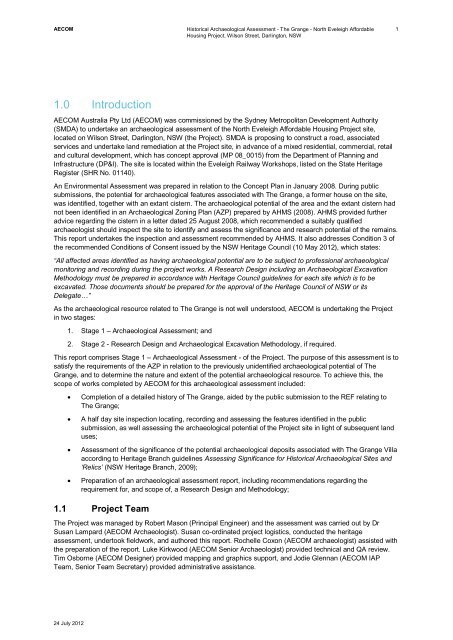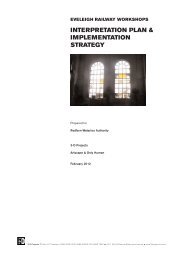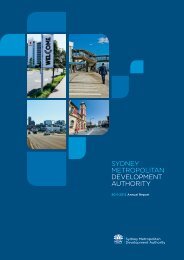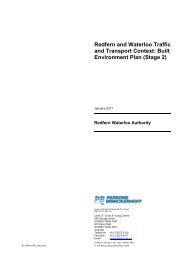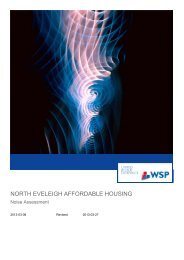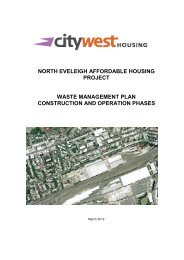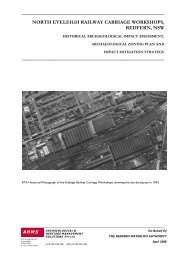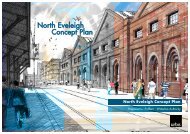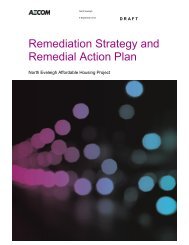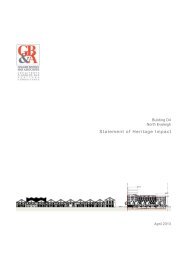Historical Archaeological Assessment - SMDA - NSW Government
Historical Archaeological Assessment - SMDA - NSW Government
Historical Archaeological Assessment - SMDA - NSW Government
You also want an ePaper? Increase the reach of your titles
YUMPU automatically turns print PDFs into web optimized ePapers that Google loves.
AECOM<br />
<strong>Historical</strong> <strong>Archaeological</strong> <strong>Assessment</strong> - The Grange - North Eveleigh Affordable<br />
Housing Project, Wilson Street, Darlington, <strong>NSW</strong><br />
1<br />
1.0 Introduction<br />
AECOM Australia Pty Ltd (AECOM) was commissioned by the Sydney Metropolitan Development Authority<br />
(<strong>SMDA</strong>) to undertake an archaeological assessment of the North Eveleigh Affordable Housing Project site,<br />
located on Wilson Street, Darlington, <strong>NSW</strong> (the Project). <strong>SMDA</strong> is proposing to construct a road, associated<br />
services and undertake land remediation at the Project site, in advance of a mixed residential, commercial, retail<br />
and cultural development, which has concept approval (MP 08_0015) from the Department of Planning and<br />
Infrastructure (DP&I). The site is located within the Eveleigh Railway Workshops, listed on the State Heritage<br />
Register (SHR No. 01140).<br />
An Environmental <strong>Assessment</strong> was prepared in relation to the Concept Plan in January 2008. During public<br />
submissions, the potential for archaeological features associated with The Grange, a former house on the site,<br />
was identified, together with an extant cistern. The archaeological potential of the area and the extant cistern had<br />
not been identified in an <strong>Archaeological</strong> Zoning Plan (AZP) prepared by AHMS (2008). AHMS provided further<br />
advice regarding the cistern in a letter dated 25 August 2008, which recommended a suitably qualified<br />
archaeologist should inspect the site to identify and assess the significance and research potential of the remains.<br />
This report undertakes the inspection and assessment recommended by AHMS. It also addresses Condition 3 of<br />
the recommended Conditions of Consent issued by the <strong>NSW</strong> Heritage Council (10 May 2012), which states:<br />
“All affected areas identified as having archaeological potential are to be subject to professional archaeological<br />
monitoring and recording during the project works. A Research Design including an <strong>Archaeological</strong> Excavation<br />
Methodology must be prepared in accordance with Heritage Council guidelines for each site which is to be<br />
excavated. Those documents should be prepared for the approval of the Heritage Council of <strong>NSW</strong> or its<br />
Delegate…”<br />
As the archaeological resource related to The Grange is not well understood, AECOM is undertaking the Project<br />
in two stages:<br />
1. Stage 1 – <strong>Archaeological</strong> <strong>Assessment</strong>; and<br />
2. Stage 2 - Research Design and <strong>Archaeological</strong> Excavation Methodology, if required.<br />
This report comprises Stage 1 – <strong>Archaeological</strong> <strong>Assessment</strong> - of the Project. The purpose of this assessment is to<br />
satisfy the requirements of the AZP in relation to the previously unidentified archaeological potential of The<br />
Grange, and to determine the nature and extent of the potential archaeological resource. To achieve this, the<br />
scope of works completed by AECOM for this archaeological assessment included:<br />
<br />
<br />
<br />
<br />
Completion of a detailed history of The Grange, aided by the public submission to the REF relating to<br />
The Grange;<br />
A half day site inspection locating, recording and assessing the features identified in the public<br />
submission, as well assessing the archaeological potential of the Project site in light of subsequent land<br />
uses;<br />
<strong>Assessment</strong> of the significance of the potential archaeological deposits associated with The Grange Villa<br />
according to Heritage Branch guidelines Assessing Significance for <strong>Historical</strong> <strong>Archaeological</strong> Sites and<br />
‘Relics’ (<strong>NSW</strong> Heritage Branch, 2009);<br />
Preparation of an archaeological assessment report, including recommendations regarding the<br />
requirement for, and scope of, a Research Design and Methodology;<br />
1.1 Project Team<br />
The Project was managed by Robert Mason (Principal Engineer) and the assessment was carried out by Dr<br />
Susan Lampard (AECOM Archaeologist). Susan co-ordinated project logistics, conducted the heritage<br />
assessment, undertook fieldwork, and authored this report. Rochelle Coxon (AECOM archaeologist) assisted with<br />
the preparation of the report. Luke Kirkwood (AECOM Senior Archaeologist) provided technical and QA review.<br />
Tim Osborne (AECOM Designer) provided mapping and graphics support, and Jodie Glennan (AECOM IAP<br />
Team, Senior Team Secretary) provided administrative assistance.<br />
24 July 2012


